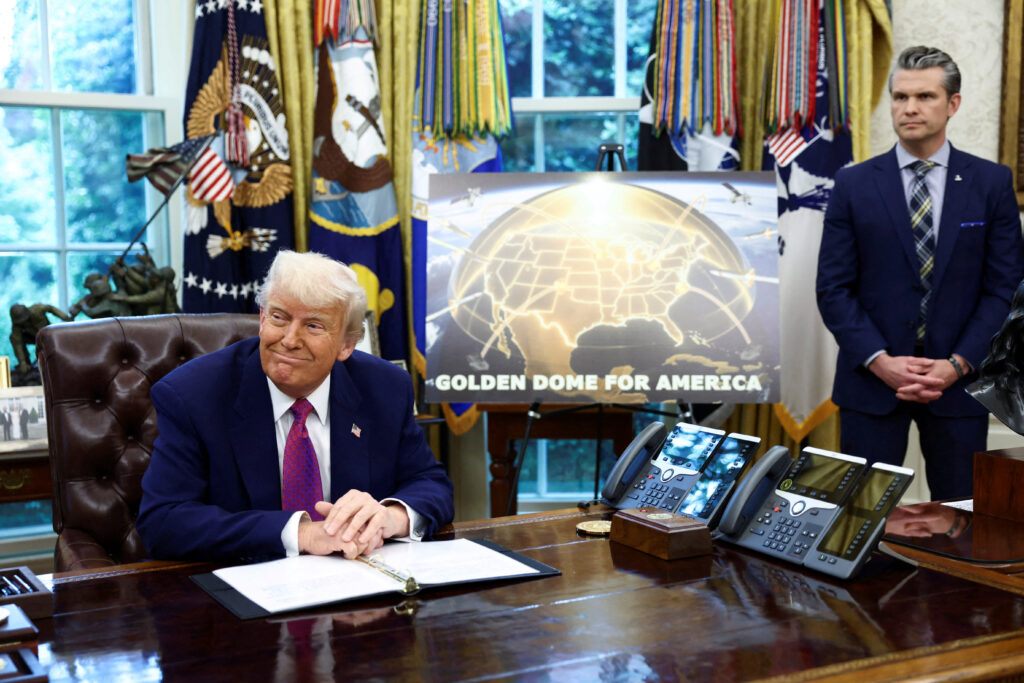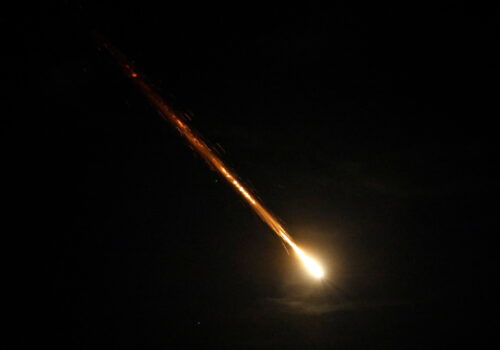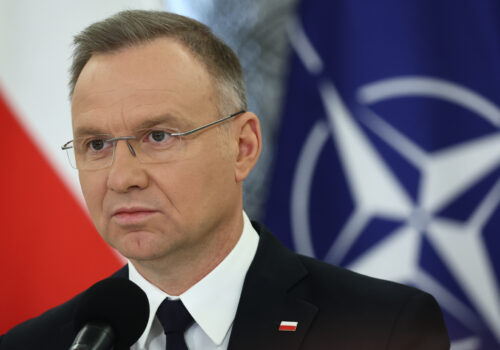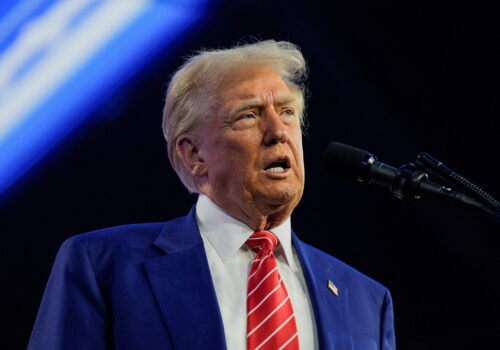New details are emerging about the White House’s “Golden Dome” initiative, a missile-defense system intended to intercept long-range and hypersonic missiles fired at the United States. Even in its early stages, the initiative looks set to become the focal point of US missile defense policy. On Tuesday, US President Donald Trump announced an initial $25 billion investment out of a total $175 billion to start building Golden Dome with the aim of completing it within his term. US Secretary of Defense Pete Hegseth further laid out that Golden Dome will be a layered system, will draw from existing and future technologies as it is phased in over time, and will have an open architecture, allowing multiple companies to contribute to it.
The announcement defied some of the policy discussions around Golden Dome so far, which have focused on its technical feasibility and relevance vis-à-vis Chinese, Russian, and North Korean missile arsenals. Golden Dome proponents seek to address challenges to homeland and extended deterrence as the United States faces what it describes as a two-peer or near-peer threat environment. However, less attention has been dedicated to how Golden Dome could impact US partnerships worldwide, potentially offsetting some of the political costs of a diminished US troop presence abroad.
US missile defense has always involved cooperation with regional partners. The United States exercises broad influence in the production and planning of missile defense programs in Europe, Asia, and the Middle East. The executive order that first outlined Golden Dome, which Trump signed in January, reiterated this international dimension of missile defense. The executive order called for increasing bilateral and multilateral cooperation on missile defense technology development, capacities, and operations. And in his address Tuesday, Trump explicitly cited Canada as a potential first partner for the implementation of Golden Dome.
Although the details of Golden Dome remain unclear, the Trump administration should seek to hold a revived missile defense dialogue with US partners and allies across Europe, Asia, and the Middle East. Such a dialogue would serve the Trump administration’s agenda in its strategic, political, and industrial dimensions. However, the success of this dialogue and effective missile defense collaboration will require overcoming technical military challenges, as well as carefully addressing the sensitivities of regional partners. In particular, this means being careful not to overstate Golden Dome’s role in the United States’ pledges of extended deterrence to its allies.
Can US missile defense help the Pentagon prioritize the Indo-Pacific?
Renewing US investment in missile defense could be seen by the current administration as a way to help reassure allies from the threat of potential adversaries such as Russia, China, North Korea, and Iran while mitigating the need for a massive deployment of US troops on the ground. This logic is not new. During the Obama administration, US officials conveyed to NATO allies that deploying missile defense systems in Europe would compensate for the reduction in the number of army brigades deployed on the continent. The origins of Poland’s Aegis Ashore system in Redzikowo, officially transferred to NATO in November 2024, date back to the decisions taken by the Obama administration.
Given the Trump administration’s desire to reduce the US military footprint worldwide and focus on strategic competition with China, missile defense could be a convenient way to maintain global influence while lowering overseas troop commitments. From the outset, missile defense has always involved advanced technologies, demanding years of research and development that only a few countries can afford. If Golden Dome achieves its goals, it will shift resources to develop space-based missile defense systems. This could disrupt the current market for missile defense, which is made up mainly of ground and naval-based sensors and interceptors. Today, none of the US allies and partners in Europe, the Middle East, or Asia has a space industry that could credibly invest in this new domain. Consequently, it is likely that strategic cooperation on Golden Dome means allies procuring future US missile defense systems and added incentives for co-production. A few regional partners are engaged in the co-production of US missile defense systems, such as Japan* for the surface-to-air SM-3 and PAC-3 missiles. Last April, Japan proposed the co-production of SM-6 new-generation long-range ship-to-air missiles. Israel may be interested in similar collaborations, as its main missile defense systems (Iron Dome, Arrow, David’s Sling) already rely on co-development and co-production with the United States.
For a broader allied collaboration on missile defense production to take shape, however, the United States will need to navigate several military and diplomatic difficulties in dialogues with its partners.
Different allies, different reassurance needs
First, US partners in Europe, the Middle East, and the Indo-Pacific face different threats from their respective adversaries’ missile capabilities. Golden Dome is conceived to address global competitors launching an intercontinental ballistic missile at US territory. It is planned to include space-based interceptors, which could prove effective in defending allies against adversaries using long-range ballistic missiles—for instance, if Russia were to launch a strike against Europe.
However, Europeans are also worried about shorter-range cruise missiles and drone campaigns such as the one launched by Russia in Ukraine, which requires different systems to address. In light of Ukraine’s experience, Europeans started addressing their capability gaps to protect against a full spectrum of air threats (cruise missiles, ballistic and hypersonic missiles, aircraft, and unmanned aircraft sysems). Meanwhile, the Gulf states and Israel face the threat from rockets and missiles fired by Iran or its proxies.
The ability of missile defense to reassure local partners varies according to the severity of the threat. For instance, in the extreme scenario of a total US withdrawal of troops from South Korea, it is unlikely that Seoul would view US missile defense as a credible substitute for US boots on the ground as a defense against North Korea. Lastly, allies and partners are unlikely to receive the same amount of attention. The United States is prioritizing the Indo-Pacific theater, and Golden Dome is intended as a technological breakthrough in the space domain—an area where China is rapidly advancing. This will lead European and Gulf states to fear being left out of any new missile defense arrangement.
Golden Dome and Alliance politics
The second challenge facing Washington lies in the disparities in the regional security architectures in Europe, Asia, and the Middle East. In the past two decades, the United States has only succeeded in creating a truly regional framework for missile defense in Europe.
In the Middle East and Asia, most US missile defense cooperation is bilateral. The lack of regional integration often results from distrust among local partners. It is also caused by the reluctance of countries in these regions to tie their national security prerogatives to an intergovernmental mechanism heavily dependent on Washington. This constrains the United States’ ability to apply missile defense cooperation lessons from NATO elsewhere.
In the Middle East and Asia, Washington must build on its existing cooperation frameworks and should consider exploring new formats. The August 2023 Camp David Summit opened up the development of a trilateral security cooperation framework with Japan and South Korea, with more consultation, information-sharing, and cooperation designed to accompany the integration of Indo-Pacific missile defense architecture. The three countries have since implemented real-time information sharing about North Korean missile launches. Additionally, missile defense could become an item on the agenda of the Quadrilateral Security Dialogue, or between NATO and its four Asian partners—Japan, South Korea, Australia, and New Zealand.
Washington will also have to accommodate the different industrial interests of its partners. Today, US allies have domestic defense industries with their own missile defense programs to protect. In Asia, countries such as South Korea and Japan have produced their own missile defense systems. Even though they will keep procuring US products, their governments will carefully protect their industrial bases. In Europe, the Sky Shield initiative, launched in 2022 by twenty-four participating countries, will rely on US Patriot and Israeli Arrow batteries. France fiercely opposed the initiative in the name of strategic autonomy, to no avail.
However, Sky Shield may not reflect the current state of US-European relations. Golden Dome emerges amid a transatlantic crisis in which Europeans are trying to become more self-sufficient in their defense. Their desire for strategic autonomy and the need to protect the European defense industrial base mean they will likely pursue their own version of missile defense. In this case, European governments must make clear the areas where they intend to design and produce their own systems, including investments in the space domain.
Differences in political priorities and strategic culture are inevitable, but consultations should identify the space for common interests between the United States and its allies. The case of Israel offers positive lessons on cooperation in missile defense. The US and Israeli militaries have very few things in common when it comes to threat assessment, force structure, and doctrine, not to mention Israel’s desire to protect its national defense industry. But both countries—and their defense industries—have found ways to develop missile defense technologies to mutual benefit.
Ultimately, the success of a renewed missile defense dialogue will boil down to how much cooperation on the Golden Dome project can serve the security interests of US partners. While the deterrent value of missile defense remains limited, Golden Dome could play a complementary role. With nuclear and missile threats becoming ever more serious, the question of how to defend against such attacks has never been more salient in allied capitals, be they in Europe, the Middle East, or the Indo-Pacific.
Léonie Allard is a visiting fellow at the Atlantic Council’s Europe Center, previously serving at the French Ministry of Armed Forces.
Jean-Loup Samaan is a senior research fellow at the Middle East Institute of the National University of Singapore, as well as a nonresident senior fellow at the Atlantic Council’s Scowcroft Middle East Security Initiative.
Correction: This article was updated on May 29, 2025 to reflect the fact that multiple regional partners engage in co-production of US missile defense systems. A previous version of this article incorrectly stated that Japan was the only country to do so.
Further reading
Fri, Jan 31, 2025
What the Gaza war reveals about the limitations of missile defense
MENASource By Jean-Loup Samaan
The Gaza War serves as a cautionary tale about what missile defense can achieve, what it should achieve, and where it falls short.
Fri, Mar 14, 2025
Why Poland’s president wants US nuclear weapons
New Atlanticist By Marek Magierowski
President Andrzej Duda said this week that US nuclear weapons should be deployed in his country. To understand why, look at not just Poland's security but also its politics.
Fri, Jan 17, 2025
Eight big ideas for the second Trump administration
New Atlanticist By
President-elect Donald Trump has promised to shake up US policies early in his second term. Atlantic Council experts share eight ideas on where to start.
Image: US President Donald Trump makes an announcement regarding the Golden Dome missile defense shield next to US Defense Secretary Pete Hegseth in the Oval Office of the White House in Washington, DC. May 20, 2025. REUTERS/Kevin Lamarque.




